- Register
- Log in to Tune-In
- Wishlist (0)
-
Shopping cart
(0)
You have no items in your shopping cart.
Beatles News

George Martin dubbed it “the song I hated most of all.” In his book Here, There and Everywhere, Geoff Emerick called it “substandard,” a “weak track” with “minimal content that seemed to go nowhere.” Ian MacDonald dismissed it as “dismal” and a “self-indulgent dirge” in Revolution in the Head. George Harrison later described it as a “piss take.”
Indeed, “Only a Northern Song” is rarely ranked among fans’ favorite Beatles songs. Does the song deserve to be dismissed as insignificant? It may not be listed among all-time favorites, but the track is notable for its psychedelic elements, as well as addressing a piece of Beatles history.
Indirectly, “Only a Northern Song” references the Beatles battle over publishing rights. How the Beatles lost ownership of their own songs dates back to 1963, when Brian Epstein decided to form a publishing company that would maintain ownership of the Beatles’ compositions. Music publisher Dick James, Epstein, John Lennon, and Paul McCartney became majority owners of Northern Songs, Ltd. The two Beatles each owned 20 percent of the business. Just two years later, Nor details
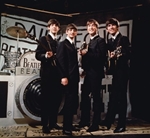
The Beatles still rake in £67,000 a day from a company they formed before they split, nearly 50 years ago.
Apple Corps, set up in 1968 to manage their affairs, declared a turnover of £24.4 million for the year ending January 31.
It is owned by surviving Beatles Sir Paul McCartney and Ringo Starr, as well as George Harrison and John Lennon’s widows Olivia and Yoko Ono. Accounts show each was paid £2.97 million in “aggregate fees for promotional services, name and likeness”.
Profit before tax rose to £5.7 million – £3.9million up on 2016.
The company – which doesn’t even own the Beatles back catalogue of songs – made £10million from 2016 documentary The Beatles: Eight Days a Week – The Touring Years. It has previously cashed in on The Beatles: Rock Band video game.
Apple Corps – which had a long dispute over its name with Apple computers – reports having £16.9million in cash. But Sir Paul McCartney, 75, is thought to be worth £780 million alone. The band split in 1970.
Source: Mark Jefferies

Ringo Starr remembered his "good friend" Tom Petty in a new interview following the rock icon's death at the age of 66.
"I'll miss Tom. Tom was a good friend. I played with Tom, Tom played with me. I got to know him over the years, really got to know him when he was in the [Traveling] Wilburys 'cause of George [Harrison]," Starr told Billboard.
"All through my career we've lost really great friends, and people who aren't my friends, but were great musicians and writers. In our business we've lost them very young as well. But overall there's still a lot of us out there doing what we do."
Starr happened to be in Las Vegas on business at the time of the Route 91 Harvest Festival shooting, which occurred hours before Petty's death.
Source: Daniel Kreps
details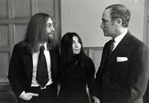
In the final year of the turbulent 1960s, as the Vietnam War and the massive counter-cultural protests against it reached new levels of intensity, John Lennon and Yoko Ono visited Canada three separate times.
The purpose of these trips varied, but on the third and final one they achieved what seems to have been among their top priorities as the leading peace activists of the era: they met the prime minister of Canada, Pierre Trudeau.
During John and Yoko’s first visit in the spring of 1969, they staged their famous “Bed-In” at the Queen Elizabeth Hotel in Montreal, lying down together for eight days in front of the world’s media to publicize their message of peace, and in the middle of it all recording their anti-war anthem Give Peace a Chance.
Source:Robert Morrison
details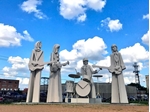
I finally got a look at sculptor David Adickes' giant statues of the Beatles. John, Paul, George, and Ringo, four tons per Beatle, stand in the backyard of 8th Wonder Brewery, located near downtown Houston.
“We have an agreement for the Beatles statues to be here for at least one year,” said Ryan Soroka, “entrebrewneur” and president of the craft brewery. “We have plenty of room for them in our backyard. Like everyone, I grew up with the Beatles music, so I’m honored and happy to have them. People take photos with the statues. It’s pretty cool.”
As part of the deal, Soroka had to pay for the statues to be disassembled and transported from Adickes' property off I-10 to the brewery. John, Paul, and George each were delivered in three pieces, while the more elaborate Ringo sculpture arrived in five pieces because of his drum kit.
Source:Eric Sandler
details

Sir Paul McCartney remembers John Lennon on 77th birthday.
The musician wrote he was “reaching out to Johnny on his birthday” in a post on Twitter alongside an old photograph of the pair.
In the black and white snap, Sir Paul is reaching across a recording studio towards Lennon.
details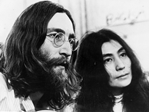
Over 40 years since the Beatles celebrated the peak of their career and changed music forever and today (9 October) would have been John Lennon’s 77th birthday.
A singer, songwriter, and activist, Lennon’s work remains at the inspirational core of popular music and is cherished in the heart of fans across the world.
On his birthday, we look back at the seven best lyrics of his career.
Tomorrow Never Knows, 1966
‘Turn off your mind, relax and float downstream
It is not dying, it is not dying’
Closing the 1966 Beatles album Revolver, ‘Tomorrow Never Knows’ pinpoints the moment the band took a leap towards a more psychedelic future. The vast imagery in the song’s lyrics was adapted from The Psychedelic Experience: A Manual based on the Tibetan Book of the Dead.
Source: Independent News
details

Paul McCartney has announced plans to re-release standard versions of the first eight installments of his Archive Collection — the series of remastered reissues of his post-Beatles albums — on November 17.
The titles — 1970’s McCartney, 1971’s Ram, 1973’s Band on the Run, 1975’s Venus and Mars, 1976’s At the Speed of Sound, 1980’s McCartney II, 1982’s Tug of War and 1983’s Pipes of Peace — will be available as single-CD digipaks, 180-gram black vinyl LPs and limited-edition colored vinyl discs, with each of the latter vinyl releases coming in a different color.
The new vinyl releases feature restored artwork and come packaged with download cards that give fans access to digital versions of the albums’ tracks. Sir Paul oversees all aspects of each installment of the Paul McCartney Archive Collection, which launched in 2010 with the reissue of Paul McCartney and Wings‘ Band on the Run.
Source: Columbus News Team
details
It's hard to imagine a time when the Beatles weren't world famous, but in November of 1963, they were still on the cusp of international stardom. They had gained notoriety in the UK, but were still months away from their iconic appearance on the Ed Sullivan show in the States, and the British foursome was invited to play the Queen's annual Royal Variety Performance.Little did George, Paul, and Ringo know that near the end of their four-song set, John Lennon would utter a phrase that would go down in the annals of pop history. Queen Elizabeth II, a lifetime patron of the Royal Variety Charity, couldn't attend the concert as she was pregnant with Prince Edward, but in her place, the Queen Mother and Princess Margaret would represent the monarchy. From the beginning, there was concern over the newly cleaned up mop tops playing for the royal family.
Source: Caroline Hallemann
details
Beatles stars Paul McCartney and Ringo Starr have paid tribute to the late Tom Petty.
Rock icon Petty suffered a cardiac arrest at his home in California on Sunday (October 1) and died in hospital yesterday (October 2) at the age of 66.
The Tom Petty NME obituary: 1950 – 2017
As tributes to pour in from Petty’s musical contemporaries, McCartney and Starr have both sent messages of condolence via Twitter.
“Sending love to Tom Petty and his family at this difficult time,” McCartney wrote, before adding: “so sad to hear of his passing. What a lovely, intelligent and talented man he was.”
Starr, meanwhile, wrote: “God bless Tom Petty, peace and love to his family”. He added: “I’m sure going to miss you Tom”. See those tweets below.
Source: Luke Morgan Britton
details

Alan Parsons has been the major influence behind some of the most successful albums in history
He is the go-to producer for established artists who crave his authentic, warm and detailed sound on their recordings.
This is no surprise given that he learned his trade under the tutelage of the late, great Sir George Martin.
He is famous for his deft influence on the sound of Pink Floyd's Dark Side Of The Moon and The Beatles' Abbey Road and Let It Be albums.
Parsons and his songwriting partner Eric Woolfson achieved major success in the own right with The Alan Parsons Project, selling more than 60 million albums.
Source: Express.com
detailsThe Rock and Roll Hall of Fame induction ceremony often brings together once-in-a-lifetime combinations of musicians — and the 2004 iteration was no different. Late rockers Tom Petty and Prince joined forces with Steve Winwood, Jeff Lynne, and more to perform George Harrison’s beloved Beatles anthem “While My Guitar Gently Weeps.”
Petty, who died Monday at 66, had a close relationship with Harrison. The two collaborated, along with Lynne, Roy Orbison, and Bob Dylan, in the popular act the Traveling Wilburys, in the late ’80s and early ’90s.
Source: Eric Renner Brown
details

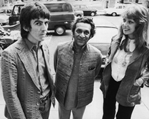
A sitar owned and played by George Harrison has been sold for $62,500 (£46,581) in the United States.
The instrument, purchased from a shop on London's Oxford Street in 1965, was used by Harrison during the recording of the Beatles song Norwegian Wood.
The Indian string instrument, crafted by a well-known music shop in Kolkata, was later gifted to a friend of Harrison's first wife, Patti Boyd.
The name of the successful bidder has not been disclosed by the auctioneers.
Bidding for the sitar began on 28 September at $50,000 (£37,327).
Harrison had discovered the sitar in 1965, on the set of the Beatles' second film, Help.
Source:BBC
details

Longtime Beatles' producer George Martin's scores for several of the group's films will be among the tracks on George Martin: The Film Scores and Original Orchestra Compositions, a posthumous compilation due out November 10.
The set, recorded by the Berlin Music Ensemble conducted by Craig Leon, who also produced the album, will include Martin's instrumental pieces from the Beatles' Yellow Submarine, as well as scores for "Live and Let Die," "Pulp" and more along with some unreleased works.
A five-and-a-half minute trailer for the album has been posted online showing Leon and the orchestra working on the material.
Leon says that the album grew out of another "unnamed" project he was working on that gave him access to the manuscripts of Martin's scores.
Source: Erica Banas
details
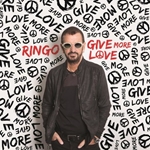
Ringo Starr, famous for being a quarter of the Beatles and one of two still living, released his 19th studio album on Sept. 15 after a two year hiatus. For being such a legendary musician, Starr honestly let me down with this new album, “Give More Love."
I had hope for a promising, fruitful album upon listening to the first track, “We’re on the Road Again,” with its triumphant guitars and catchy sound. The lyrics are symbolic of his return to music and touring with this latest release. Former Beatles bandmate Paul McCartney and Eagles’ guitarist Joe Walsh collaborated on this song, which provides all the explanation for why it is arguably one of the album’s best. Yet, the song set up a false pretense that the rest of the album would be as good as the opener.
Source:Ysabella Ramirez
details